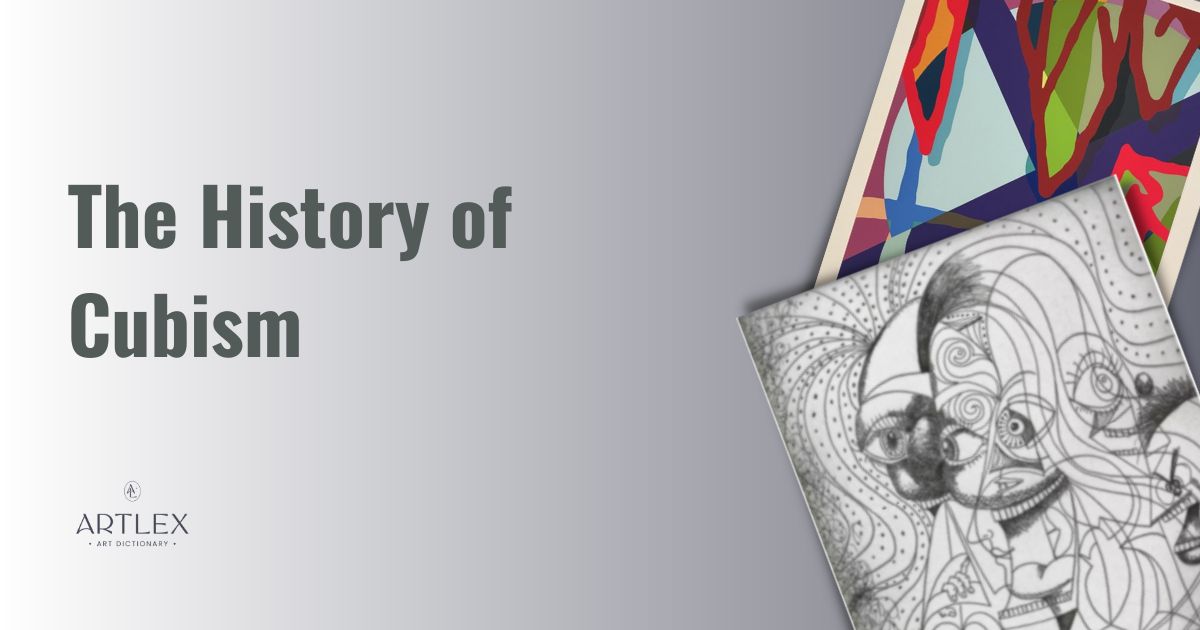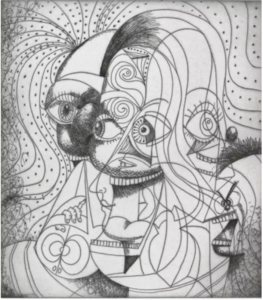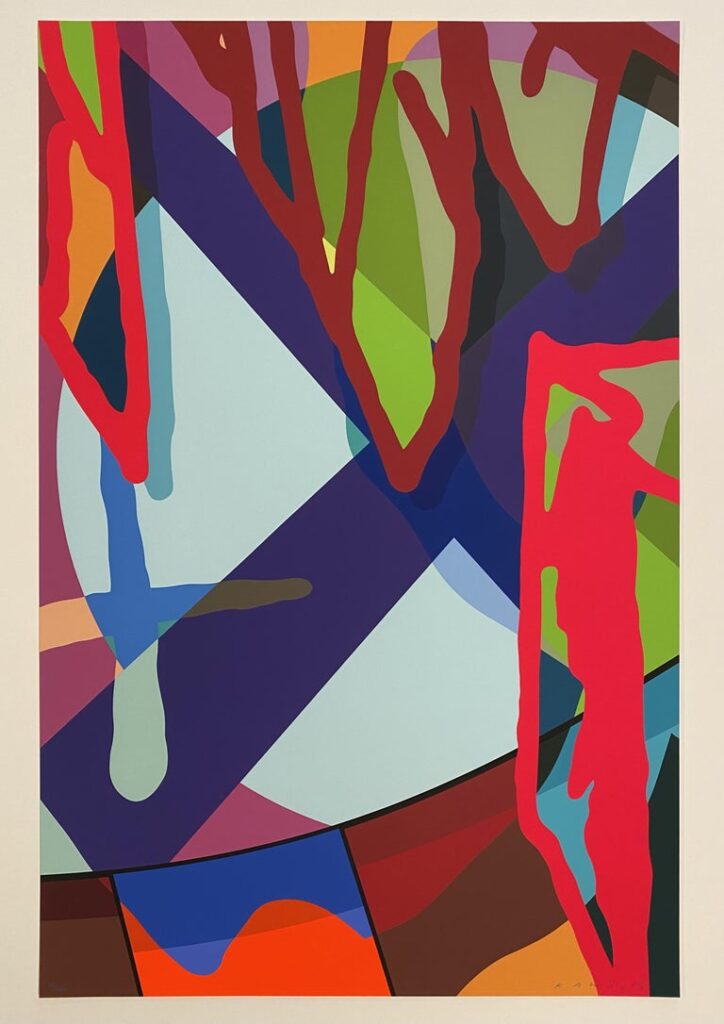
Cubism is a Modern art movement that emerged around 1907 in Paris, France. The Cubist movement consisted of two major phases: Analytic Cubism and Synthetic Cubism. Cubist artists reimagined conventional representation by rejecting the traditions of perspective, modeling, and foreshortening favored during the Renaissance. The result of this method was a heavily abstracted composition that represented the subject from all angles or with overlapping picture planes.
When was Cubism Invented?
Cubism was invented in 1907 by artists Pablo Picasso (1881-1973) and Georges Braque (1882-1963). The term Cubism originated from a comment by art critic Louis Vauxelles in 1908, who described Georges Braque’s paintings as a reduction of the subjects to “geometric outlines, to cubes” [1].
Who Inspired Cubism?
French Post-Impressionist artist Paul Cézanne (1839-1906) primarily influenced the Cubist movement. Though Cézanne’s experiments with planes and perspective are modest compared to those of Cubism, his use of hard lines, geometric shapes and simultaneous perspectives profoundly impacted Cubism’s aesthetic.
In addition to Cézanne, other art styles, such as Cycladic and African art, also inspired Cubism. Cubism borrowed aesthetic elements from African and Cycladic art, leaving behind the symbolic function of many artifacts.
African tribal masks present a vivid human image but are not naturalistic, in the sense that the specific parts of a face are all present but are abstracted in some way. In Cycladic art, sculptures of people are also reduced to their basic forms, such as elongated faces hardly having more than the bridge of a nose and a neck for support.
The reduction to essential elements suggests that African art and Cycladic art were more concerned with the essence of an object or person rather than the minute details of its appearance. Cubism adopted this style to communicate an abstract, though not illusionistic, portrayal of the subject.
What are the Phases of Cubism?
Cubism consisted of two major phases: Analytic Cubism and Synthetic Cubism. Analytic Cubism is the first major phase of Cubism that occurred between 1907 and 1912. Synthetic Cubism is the later phase of Cubism between 1912 and 1914.
Initially, the Cubism art movement was not divided into Analytical Cubism and Synthetic Cubism. Only later would art historians label the initial phase of Cubism as Analytical Cubism and the latter as Synthetic Cubism.
History of Analytic Cubism
Analytic Cubism is the early phase of the Cubism art movement that developed around 1907 and lasted until 1912. The name Analytical Cubism describes the analytical, piece-by-piece approach artists used to represent their subjects, much like an aesthetic dissection of form.
Analytic Cubism is characterized by paintings that represent a subject from multiple overlapping viewpoints within a single picture plane. The resulting artworks have a fragmented, geometric, abstract appearance and a monochromatic color palette.
Pablo Picasso and Georges Braque were the artists at the forefront of Analytic Cubism for many years, along with Juan Gris (1887-1927).
History of Synthetic Cubism
Synthetic Cubism is the second phase of the Cubism art movement that lasted from 1912 to 1914, around the time of the first world war.
Much like Analytic Cubism, Synthetic Cubism was led by artists Pablo Picasso and Georges Braque. By 1912, many more artists were working alongside Picasso and Braque in the Cubist style, including Jean Metzinger (1883-1956), Albert Gleizes (1881-1953), Robert Delaunay (1885-1941), Henri Le Fauconnier (1881-1946) Fernand Léger (1881-1955).
Synthetic Cubism is characterized by flat depictions of everyday objects and bolder, more symbolic compositions than its precursor, Analytical Cubism. Many art historians also acknowledge the artist Juan Gris as a critical figure in the evolution of Analytical Cubism to Synthetic Cubism.
Unlike the deconstructive process of Analytical Cubism, artists working in the style of Synthetic Cubism represented their chosen subject matter, usually real objects and people, through a combination of everyday materials and oil paint. The colors used in Synthetic Cubist art are also varied and more vibrant than the monochromatic palette of Analytic Cubism.
How is Cubism Practiced Today?
Though Cubism is often written about through a historical lens, its signature style continues to inspire contemporary artists.
George Condo uses the term ‘psychological cubism’ to describe his artwork, inspired by Cy Twombly, Diego Velasquez and Pablo Picasso. Condo’s disjointed style is a clear nod to the fragmented figures of Cubism, as seen in the image below, which depicts George Condo’s The Insane Clown (2019).

KAWS, graffiti artist Brian Donnelly, is influenced by the avant-garde arrangement of Cubist subject matter and the fragmented structure of Picasso’s artwork. In works like Tension (2019), KAWS dissected familiar shapes and rearranged them on the canvas, as seen in the image below.

What Art Movement did Cubism Inspire?
Cubism was highly influential on later artists and art movements, inspiring Dadaism, Surrealism, Futurism, Suprematism, Constructivism, De Stijl, and Pop Art. Even the famed artists Frida Kahlo (1907-1954) and Salvador Dalí (1904-1989) experimented with the Cubist style before rooting themselves in Surrealism.
Papier collé, the pasted paper technique we now know as collage, also emerged from Synthetic Cubism. The method of pasting bits of paper onto a flat surface such as a canvas was often used by Cubists to confront the viewer with actual pieces of reality. By combining scraps of real-world objects with traditional art materials, Cubists demonstrated how introducing physical elements into artwork and synthesizing them into a new style could be incredibly avant-garde and influential on generations of artists to follow.
